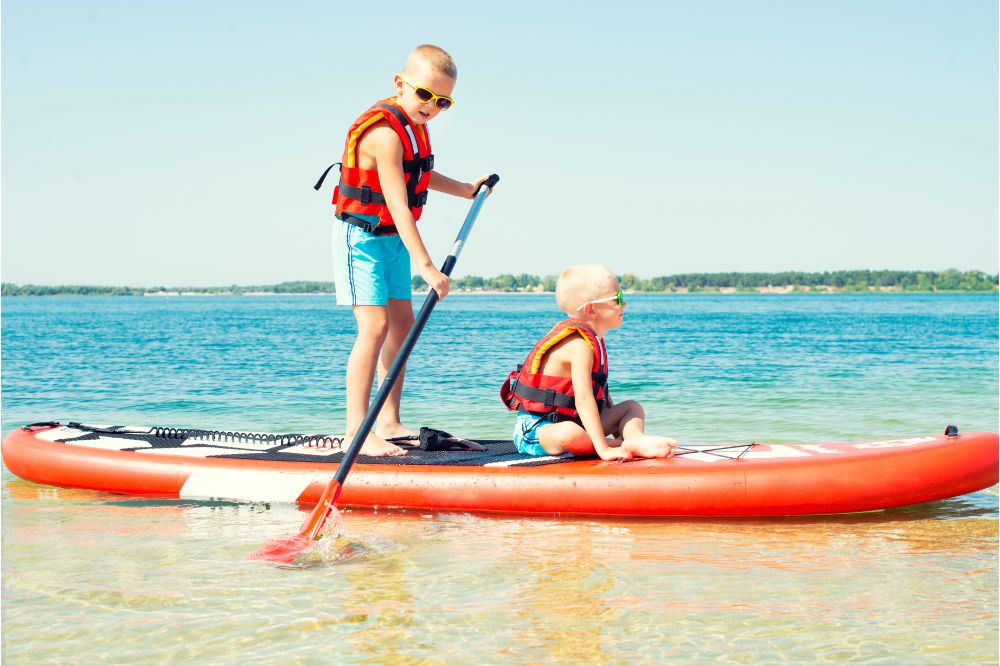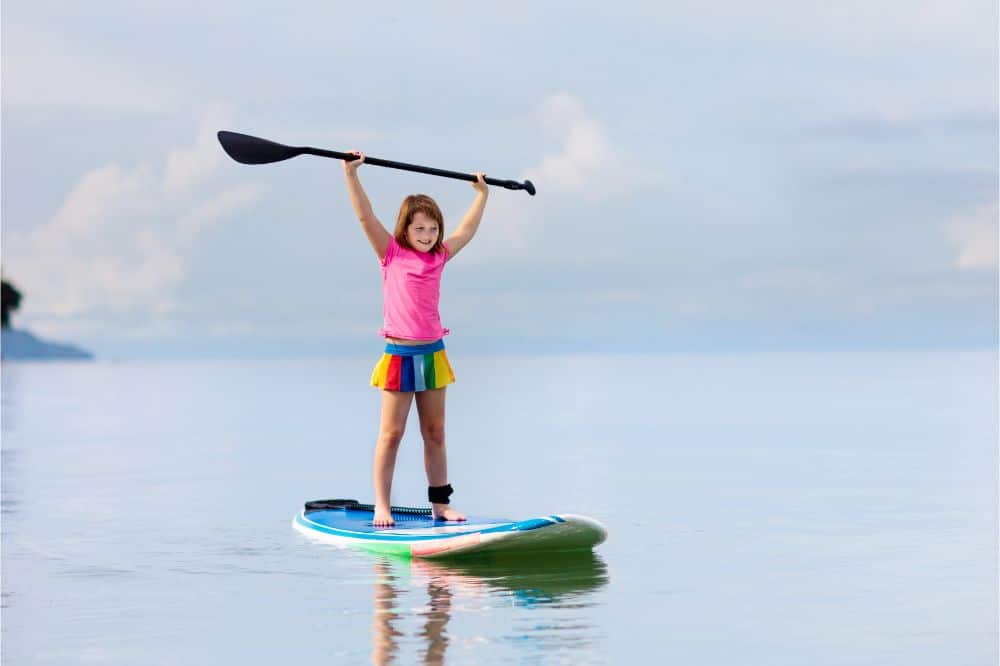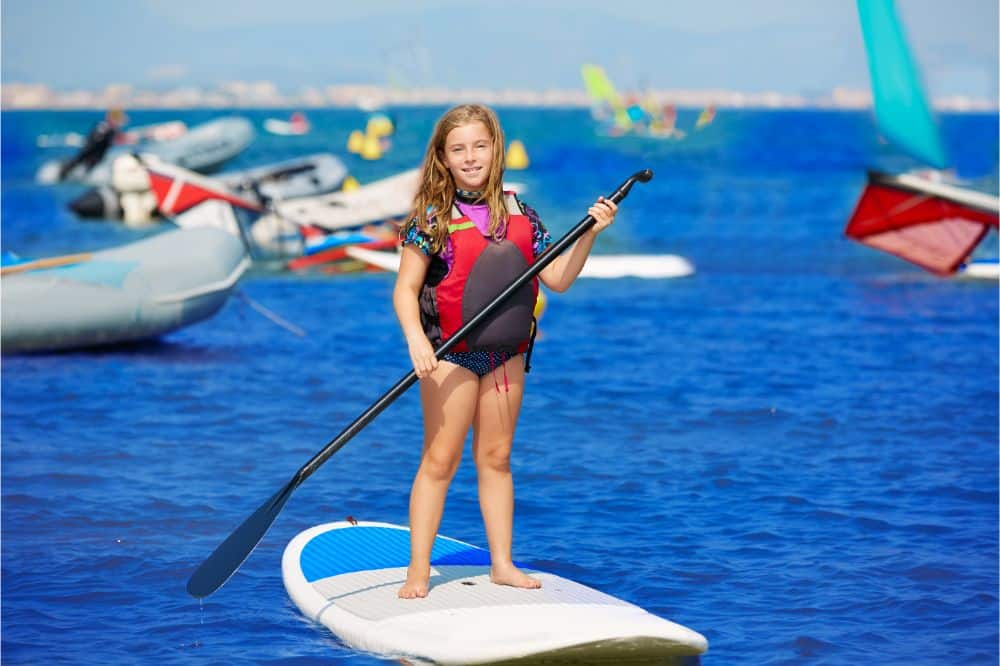Stand-Up Paddle Boarding for Kids, is an exciting and enjoyable water activity that promotes a healthy and active lifestyle while engaging with the great outdoors.
This water sport is not only fun and easy to learn but also helps kids develop essential skills, such as coordination, balance, and strength.
Stand-Up Paddle Boarding allows children to experience the beauty of nature, build self-confidence, and create lasting memories with friends and family. Get ready to embrace the water, soak up the sun, and embark on a journey of adventure and discovery through the wonderful world of Stand Up Paddle Boarding for kids!

Most important tips for stand-up paddle boarding for kids
Stand-Up paddle boarding (SUP) can be a fun and rewarding activity for kids, as it promotes physical and mental well-being, improves balance and strength, and teaches them to connect with nature. The following are essential tips for introducing Stand-Up paddle Boarding to kids.
1. Choose the right equipment: Ensure you have a stable and kid-friendly board, which is neither too big nor too small. A good starting point for children is an all-around inflatable board, as these are generally more stable, lighter, and more comfortable to stand on.
2. Safety first: Always make sure children wear appropriate life jackets or personal flotation devices (PFDs) and use a SUP leash to avoid the board drifting away. Teach children about water safety rules and the importance of staying close to the shore and being aware of weather conditions.
3. Proper technique: Demonstrate proper paddling technique and show your child how to hold the paddle comfortably. Teach them to stand on the board with slightly bent knees and feet shoulder-width apart, maintaining a low center of gravity.
4. Start in shallow water: Children should initially practice SUP in shallow water where they can easily stand up if they fall off. Guide them through basic paddle strokes and turning techniques before venturing into deeper water.
5. Be patient: Learning to balance on a SUP can take some time. Encourage your child to keep practicing by setting small goals, such as paddling to a nearby buoy or performing a specific turn.
6. Make it fun: Incorporate fun activities and games while paddle boarding, such as relay races, obstacle courses or searching for wildlife. This will help keep children engaged and develop their paddle boarding skills.
7. Ensure supervision: Maintain close supervision when children are paddle boarding, especially when they are beginners. It is essential to stay alert and watchful to ensure their safety.
8. Choose the right location: Start in calm and shallow water, away from boat traffic, waves, and strong currents. As your child gains confidence and skills, you may explore more challenging or scenic locations.
9. Encourage camaraderie: Invite friends or classmates along for SUP outings, and help foster a sense of teamwork and togetherness in children. This can provide both social and emotional benefits.
10. Lead by example: Be a role model for safe and responsible paddle boarding, consistently demonstrating proper equipment care, paddling technique, and respect for the environment.
By following these tips, you can introduce your child to the exciting world of stand up paddle boarding and create memories that will last a lifetime.
Safety Considerations for Kids in SUP
Stand-up paddle boarding (SUP) has surged in popularity in recent years. The appeal of this water sport lies in its unique combination of excitement and serenity, offering a whole-body workout, while allowing participants to enjoy the beauty and tranquility of the water.
SUP is an incredibly versatile activity, suitable for people of all ages, fitness levels, and experiences. However, as with any water-based sport, there are inherent risks involved. Consequently, it is vital to pay heed to safety measures, particularly when participating in SUP with children.
Never let them unattended
Important safety precautions for SUP include never going alone, wearing a personal flotation device (PFD), and ensuring that equipment is appropriately sized for the child.
One of the most significant safety rules when practicing SUP is to avoid going alone, especially when taking children along. Buddying up, or participating in a group, provides the assurance of help should any mishap occur. Moreover, emergencies are less likely to escalate when assistance is readily available.
Keeping an eye on fellow paddle boarders can significantly increase response times in case of an accident, potentially averting disaster. Additionally, the collective experience and knowledge within a group can help identify and mitigate any risks – including changing weather patterns, shifting water currents, or other potential hazards.
Wear a suitable PFD
Wearing a PFD is a crucial safety measure for both adults and children while paddle boarding. A PFD ensures that, in case of an accidental fall or loss of balance, even non-swimmers and those less confident in the water remain afloat with minimal effort.
Additionally, a PFD acts as an extra layer of protection against the elements, helping to retain body heat during prolonged exposure to cold water. Children, in particular, are more susceptible to the effects of cold water and subsequent hypothermia. Hence, wearing a PFD is a small but significant step in securing their safety.
Use appropriately-sized Equipment
The use of appropriately-sized equipment is vital when introducing children to SUP. Poorly fitting gear can not only hinder comfort and enjoyment but may also compromise safety. A disproportionately large paddle, for instance, can be difficult for a child to maneuver effectively and may lead to instability, loss of balance, and falls. Moreover, an adequately-sized board will offer better stability and control, enabling the child to develop and refine their skills without compromising safety.
Teach them on the basic SUP Techniques
In order for the children to always have the board under control, it is important to practice the basics of paddling technique.
This includes in particular:
- the correct standing position
- the correct paddle technique
- the different paddle strokes to steer and control the board
- what to do when the wind comes up
- how to get back on the board in deep water
A detailed explanation of all these points can be found in our Tips&Advice section.
Conclusion about how to make SUP safe for Kids
In conclusion, the importance of safety measures in SUP cannot be overstated, as they ensure a secure and enjoyable experience for all involved. By adhering to these guidelines and fostering a culture of safety and responsibility within the SUP community, we can protect ourselves, and our loved ones, and potentially save lives. It is essential to remember that the key to a fantastic SUP experience is a blend of excitement, exploration, and adherence to proper safety protocols.

How to introduce kids to SUP
The best age to start kids on Stand Up Paddleboarding (SUP) is usually around 6-8 years old. However, this can vary depending on the child’s comfort level in the water, their ability to swim, and their overall physical strength and coordination.
Basic Techniques and Skills for Kids on SUP:
Give proper safety instructions: Before kids start paddleboarding, teach them water safety rules, including wearing a life jacket, using an ankle leash, and understanding what to do in case they fall off the board.
Help them choose the right equipment: Ensure children use a kids-specific board that is shorter and lighter than an adult’s board. Also, provide them with an adjustable paddle that can be set at an appropriate length for their height.
Teach them the proper standing position: The kids should stand in the middle of the board with their feet shoulder-width apart. Their toes should be pointed forward, knees slightly bent, and their weight evenly distributed on both feet.
Start in calm water: Begin practicing in a calm, safe environment such as a lake or bay to build confidence. Avoid areas with strong currents, large waves, or boat traffic.
Give instructions on holding the paddle: Kids should hold the paddle with one hand on the handle and the other hand about halfway down the shaft. Teach them to keep their arms straight and use their core muscles to paddle.
Teach them how to paddle: Demonstrate how to paddle on both sides of the board. Encourage them to practice switching their hands on the paddle when changing sides. The basic paddle stroke includes reaching forward with the paddle, digging the blade into the water, pulling it back towards the feet, and lifting it out of the water.
Practice turning: Teach kids how to turn the board by doing wider strokes on one side or doing a reverse paddle stroke on the opposite side.
Explain how to get back on the board after falling off: Kids should approach the board from the side, grab the handle or the sides of the board, and kick their legs while pulling themselves onto the board.
Encourage balance and stability: Suggest kids practice different balance exercises on the board, such as shifting their weight from side to side, standing on one foot, or doing squats. This will help improve their stability and overall confidence on the board.
Be patient and supportive: Learning to SUP can be challenging, so offer encouragement and be patient as kids practice and develop new skills. With time and practice, their confidence in paddleboarding will gro
The benefits of SUP for kids
SUP is not only a fun and engaging activity, but it is also highly beneficial for kids, both physically and mentally.
Physical Benefits of Stand-Up Paddle Boarding for Kids:
Improving Balance and Coordination: SUP requires a good sense of balance to stand on the board and navigate through the water. This helps kids develop better balance and coordination skills, which translates to improved motor skills in other areas of life.
Building Core Strength: The constant effort to maintain balance and propel the board engages the core muscles (abdominal, lower back, and pelvic muscles). This helps kids develop a strong core which is essential for overall physical health and performance.
Enhancing Muscle Strength: SUP works on various muscle groups, including arms, shoulders, back, and legs. Paddling with proper technique and navigating the board involves repetitive use of these muscles, promoting strength development and muscle tone.
Cardiovascular Health: SUP is a low-impact aerobic workout, which means it’s easy on the joints while still providing a good cardio workout. Kids can burn calories, improve their stamina, and maintain a healthy heart rate with regular SUP practice.
Developing Motor Skills: SUP involves various movements that require fine motor control of hand and body movements. This helps kids improve their motor skills and hand-eye coordination.
One can conclude that SUP is definitely one of the best full-body exercises you can do with your little one.
Mental Benefits of SUP for Kids:
Boosting Self-Confidence: Mastering SUP techniques and navigating the water provides kids with a sense of accomplishment and self-confidence. This confidence can transfer to other aspects of their lives, such as academics and social situations.
Reducing Stress and Anxiety: Being immersed in nature and focused on the task of paddling can help kids forget about daily stressors and anxieties, allowing them to unwind and relax.
Enhancing Concentration and Focus: SUP requires kids to remain focused and attentive to their surroundings and body movements. This can improve their concentration and focus in other areas of life, such as schoolwork.
Encouraging Mindfulness: SUP can be a meditative experience, with the rhythmic motion of paddling and the gentle sway of the water. It promotes mindfulness and helps kids connect with their thoughts, emotions, and surroundings.
Promoting Social Skills: SUP can be a social activity when kids are interacting with peers, make friends, and learning from one another. It can help enhance communication, teamwork, and leadership skills.
Comparing SUP to Other Outdoor Activities for Kids:
While there are numerous outdoor activities available for kids, each offering its unique set of benefits, SUP offers a combination of physical and mental benefits that is hard to find in other activities.
Accessibility: SUP is a low-impact, easy-to-learn sport, suitable for kids of all ages and fitness levels. This makes it more inclusive and accessible compared to more intense or skill-dependent sports.
Versatility: SUP can be done on different water bodies, such as lakes, rivers, and ocean bays, making it a versatile outdoor activity that can be enjoyed in various settings.
Combination of adventure and relaxation: SUP can be adapted to cater to different preferences – it can be an adrenaline-pumping race or a gentle glide through calm waters. This kind of flexibility in a single activity makes it appealing to a wider range of kids compared to more specialized sports.
Environmentally friendly: SUP is a non-polluting and eco-friendly activity that helps kids appreciate nature, understand the importance of environmental conservation, and develop a more responsible attitude towards the planet.
Overall, SUP offers a unique combination of physical and mental benefits for kids while allowing them to enjoy nature and explore the outdoors in a fun, engaging, and healthy way.

Choosing the right SUP board for kids
Choosing the right SUP (stand-up paddle) board for kids is essential for a fun, safe, and enjoyable experience. It’s important to consider the child’s height, weight, age, and skill level when selecting a board.
Starting with an all-around board, which usually measures 9-10 feet long and 28-32 inches wide, can be a good choice for kids learning to paddle.
Look for a board with a soft-top design, ensuring the child’s comfort and providing a better grip with wet feet. Opt for boards with a lightweight construction (usually foam or soft PVC) to make it easier for young paddlers to carry and manage.
Finally, invest in an adjustable, light-weight paddle, allowing the length to be adjusted as the child grows. With the right SUP board, kids can develop balance, coordination, and a love for water sports.
Testimonials and success stories
Interviews with parents and children who have tried SUP reveal that the experience helped in strengthening family bonds, improving fitness levels, and increasing confidence through the process of mastering a new skill.
Parents highlight the opportunity to share quality time with their children in a safe and encouraging environment, while children express enthusiasm about trying an exciting adventure that makes them feel closer to nature.
The physical benefits include improving balance, coordination, and overall body strength, as SUP engages the core, upper body, and lower body muscles. Moreover, SUP provides a unique mental health boost due to its calming effect, being close to water, and the opportunity to unplug from technology.
For parents and children interested in trying SUP, here’s some valuable advice:
- Invest in age-appropriate equipment:
Ensure that you have the right-sized paddle and board for your child, as this will make the learning process more enjoyable for them. - Start in calm waters:
Choose a flat water location, such as a lake or bay, for the first few sessions to build confidence and get accustomed to balancing on the SUP. - Take a lesson:
Signing up for a SUP lesson can help both children and parents learn the correct techniques and safety procedures. - Wear life jackets:
Safety should always be a priority. Ensure each family member wears a life jacket suitable for their size and weight. - Be patient:
Give your child the time and space they need to get comfortable on the board. Encourage them to learn at their own pace and celebrate their achievements.
In conclusion, SUP offers an exceptional opportunity for parents and children to bond, improve physical fitness, and experience the beauty of nature. With the right approach and equipment, the whole family can enjoy the numerous benefits of this inclusive and exciting outdoor activity.
Summary of the benefits of SUP for kids
Stand-up paddleboarding (SUP) offers numerous benefits for kids, including promoting physical fitness, building strength, and improving balance. SUP also fosters mental well-being, as it encourages focus and relieves stress.
Additionally, kids can learn water safety skills and environmental awareness, all while enjoying a fun, social activity in the great outdoors. Overall, SUP contributes to the healthy and holistic development of a child’s physical, mental, and emotional aspects.






